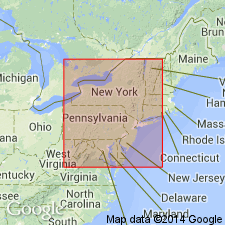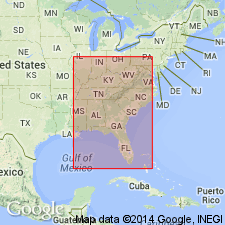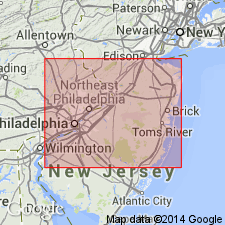
- Usage in publication:
-
- Navesink formation
- Modifications:
-
- Named
- Dominant lithology:
-
- Sand
- Marl
- AAPG geologic province:
-
- Atlantic Coast basin
Summary:
Navesink formation named in Navesink Highlands, Monmouth Co., east-central NJ. Distinguishing feature is greensand. Lower part frequently quite sandy. Upper part highly argillaceous and at top frequently arenaceous and so oxidized that it is difficult to separate from Redbank formation. Highly fossiliferous. Thickness ranges from 40 to 60 ft. Previously called Lower Marl bed. Conformably overlies Matawan formation.
Source: GNU records (USGS DDS-6; Reston GNULEX).

- Usage in publication:
-
- Navesink Formation
- Modifications:
-
- Overview
- AAPG geologic province:
-
- Atlantic Coast basin
Summary:
The lower portion of the Navesink Formation of the Monmouth Group is predominantly a deep dusky green glauconitic sand. The upper portion is dusky brown, less glauconitic and more clayey with more lignite and quartz granules. Thickness ranges from 5 ft in the southeast to 35 ft in the central part of the outcrop belt. Oyster bank assemblages common to the Navesink are dominated by E. COSTATA, PYCNODONTE CONVEXA, and AGEROSTREA MESENTERICA. Units extends from Raritan Bay at Atlantic Highlands, Monmouth Co., to the Delaware River in Salem Co. Not recognized in DE, at least in outcrop. Correlates with the Severn Formation of MD. Exposed along Poricy Brook, Big Brook, and Crosswicks Creek in Monmouth Co. and in the Iversand Pit at Sewell and at Mullica Hill in Gloucester Co. Grades into fine-grained silty glauconitic sand of the New Egypt Formation. Overlies the Mount Laurel Formation. Age is late Campanian to early Maastrichtian according to some authors and early Maastrichtian according to others.
Source: GNU records (USGS DDS-6; Reston GNULEX).

- Usage in publication:
-
- Navesink Formation*
- Modifications:
-
- Biostratigraphic dating
- AAPG geologic province:
-
- Atlantic Coast basin
Summary:
Navesink Formation shown as Late Cretaceous (middle and late Maastrichtian) age on fig. 1. Middle and late Maastrichtian age based on CRASSATELLA VADOSA collected from Monmouth Co., central NJ. [Navesink shown with query in appendix, but not on fig. 1 or in text.]
Source: GNU records (USGS DDS-6; Reston GNULEX).

- Usage in publication:
-
- Navesink Formation, sequence
- Modifications:
-
- Overview
- AAPG geologic province:
-
- Atlantic Coast basin
Summary:
The Maastrichtian unconformity-bounded sequence in the NJ coastal plain, here informally termed the Navesink sequence, includes the Navesink Formation, the Sandy Hook and Shrewsbury Members of the Red Bank Formation, and the Tinton Formation and ranges in age from 69.3 to 65 Ma based on Sr-isotope age estimates. Sequence is assigned to the calcareous nannofossil Zones CC20/21 and CC22b. High sedimentation rates in the latest Maastrichtian of NJ suggest tectonic uplift and/or rapid progradation during deposition of the highstand systems tract. The unconformable contact with the Campanian Mount Laurel Formation of the underlying Marshalltown sequence is marked by a reworked zone of a pebbly, poorly sorted, glauconite-quartz sand. The Navesink Formation is the transgressive, basal, clayey glauconite sand in a coarsening-upward sedimentary sequence. It is interpreted to be a middle-shelf deposit with large beds of calcareous shells dispersed throughout. The overlying Sandy Hook Member of the Red Bank is a massive, dark-gray, micaceous, fossiliferous, clayey silt and fine sand that grades upward into the Shrewsbury Member, a burrowed, slightly glauconitic, medium to coarse quartz sand that is unfossiliferous because of leaching. The sequence changes dramatically to the southwest along the outcrop belt. The Shrewsbury Member pinches out near New Egypt; the Sandy Hook changes from clayey fine sand to glauconite sand and pinches out several mi to the west of New Egypt, and the Navesink Formation thins or is locally absent. The Tinton Formation, uppermost Maastrichtian unit in NJ, crops out in a northern belt extending from the Atlantic Highlands southwestward to Perrineville and reaches a maximum thickness of 11 m just west of its type section. The Tinton is an unconsolidated to well-indurated, clayey, feldspathic, glauconite-quartz sand. The sequence unconformably underlies the Hornerstown Formation, dated as either Maastrichtian and early Paleocene or entirely early Paleocene.
Source: GNU records (USGS DDS-6; Reston GNULEX).
For more information, please contact Nancy Stamm, Geologic Names Committee Secretary.
Asterisk (*) indicates published by U.S. Geological Survey authors.
"No current usage" (†) implies that a name has been abandoned or has fallen into disuse. Former usage and, if known, replacement name given in parentheses ( ).
Slash (/) indicates name conflicts with nomenclatural guidelines (CSN, 1933; ACSN, 1961, 1970; NACSN, 1983, 2005, 2021). May be explained within brackets ([ ]).

